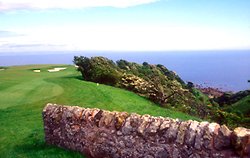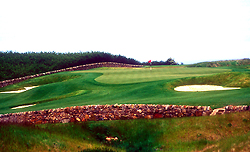New Links in Old St. Andrews
Dale LeathermanEvery golfer should play the Old Course at St. Andrews once in his life, but not overlook the new tracks near the Home of Golf.
 The seaside village of St. Andrews is the historic heart of Scotland. The world's first golf course is here, along with the country's first university and cathedral ruins dating back to the 1100s. Golf on St. Andrews Old Course was first mentioned in print in 1457, when King James II ordered his archers to stop chasing the little feather-packed ball and get back to shooting practice. It did no good. Golf, from its very beginning, was a passion not to be denied.
The seaside village of St. Andrews is the historic heart of Scotland. The world's first golf course is here, along with the country's first university and cathedral ruins dating back to the 1100s. Golf on St. Andrews Old Course was first mentioned in print in 1457, when King James II ordered his archers to stop chasing the little feather-packed ball and get back to shooting practice. It did no good. Golf, from its very beginning, was a passion not to be denied.
In this ancient setting, three miles from the revered Old Course, an American has built new golf venues and a new hotel. Oddly enough, the resort has passed muster with the discerning locals and is attracting visitors from all over the world.
It took remarkable resolve to build new golf courses (designed by Americans, yet) and an American-style resort within sight of old St. Andrews' skyline. Dr. Donald Panoz (founder of the luxury Chateau Elan resort group based in Atlanta, Georgia) measured up to the challenge. The entrepreneur bought a fallow 540-acre farm and built the $80 million, 209-room St. Andrews Bay Resort, spa and two golf courses.
The golf courses were a dream come true for Panoz and his friend, the late Gene Sarazen, who saw the setting "and knew we had something special," says Panoz. With Sarazen as a consultant, the U.S. firm of Denis Griffiths and Associates worked with designer Sam Torrance (2002 European Ryder Cup captain) on the Torrance Course in 2001, and Aussie designer Bruce Devlin on the Devlin Course in 2002.
At the heart of the two courses is a $3.5 million clubhouse with a balcony facing the sea. Off to the west is the skyline of St. Andrews and the wide town beach where scenes in "Chariots of Fire" were filmed. Across the bay is the lighthouse of the famous Carnoustie Golf Course. To the east is the seventeenth green of the Devlin Course, under which lies the remains of a 500 A.D. fort where Roman sentinels once watched for invaders from the sea.
 Head golf pro John Kerr believes the two courses will become as famous in time as the area's historic tracks. "With the designers involved and the setting, they're great courses," he says. "There aren't many courses with a better view, and they're challenging. On the Devlin there are places you have to put the ball up in the air and fly the greens or you'll lose a ball in the thick rough.
Head golf pro John Kerr believes the two courses will become as famous in time as the area's historic tracks. "With the designers involved and the setting, they're great courses," he says. "There aren't many courses with a better view, and they're challenging. On the Devlin there are places you have to put the ball up in the air and fly the greens or you'll lose a ball in the thick rough.
"The Torrance is more traditional," he adds. "You can bounce the ball into the greens. With the wind waving the tall yellow fescue, the Torrance rough is intimidating, but you can walk in and find your ball. It may grab your club getting out of it, but at least you can find it."
Both courses are crisscrossed by ancient stone walls. Equally ancient stone bridges span the burn (creek) running through the Torrance. The walls along the cliffside perimeter are overrun by flowering yellow gorse and broom, white quince, red campion and tiny, delicate bluebells.
Bussed almost constantly by ocean breezes, the Devlin is home to high rough and devilish bunkers. Over-sized greens, some serving two holes, look inviting but are subtly sculpted. The track follows rolling high ground around duck ponds, stone walls and copses of trees, then loops back to the cliffs. The greens there are optical illusions suspended against sea and sky, confounding club selection.
The finishing holes are superb. Seventeen, a long par 4, is a blind shot over the crest of a hill. The fairway falls away to the right, 175 yards downhill to the seaside green. Go long on your first shot and you're in bunkers beyond the dogleg; fall short and you have to skirt the precipitous ravine called Kittocks Den. Eighteen is a well guarded par 3 with a backdrop of St. Andrews and the beach.
From the hotel the Torrance looks like a sea of rippling brown grass seamed here and there with stone walls. A traditional, walking only course, it becomes more impressive with every hole, unfolding with the character and forethought of a lovingly crafted quilt.
Though it looks as if it has been here 100 years, two things about the Torrance are unusual. Most links courses are deprived of sea views by a range of dunes. On the Torrance (and Devlin) the sea is visible from most holes. Secondly, few older courses loop back to the clubhouse on the ninth hole as these tracks do—a convenience most Americans expect.
We played the Torrance with chief greens keeper Neil Ballingall, a pleasant fellow who is attentive to detail, as the condition of the course shows. His greens are fast and true, and the sand in his bunkers is precisely the right grain size (fine sand will blow out).
Scottish fairways are typically seeded in fescue and bentgrass, but the mix on the Torrance incorporates a bit of rye, says Ballingall. "It's a conference hotel (it has the largest hotel-based conference facilities in Scotland), so the rye makes the ball sit up for people who play infrequently. Yet the pros like it, too, because they get the reaction they want from the ball."
There are no dull holes on the Torrance, but the back nine has the most spectacular ocean holes. At fourteen, a short par 4, the track drops to a pretty seaside green by way of a split fairway lined with a rock wall overrun with flowering bushes. The floral show extends along the next hole, a 183-yard par 3 where the wind calls the shots. The top-handicapped seventeenth hole is a par 4 with a brush-filled gorge and rock wall intruding on the fairway. Depending on the wind, it can be a long shot over the wall to the green. Eighteen is a long uphill par 5 that breaks sharply left on the third shot to a seaside green.
When you're heading home late in the day on either track, the setting sun casts a golden glow over the courses, and it's easy to pretend they've occupied this precious bit of land forever.
The Resort
St. Andrews Bay, one of only four 5-Star international hotels in Scotland, is a stately, native stone edifice that blends seamlessly into the waving grasses of the golf courses that flank it. However, on the inside it is not like any other hotel in the area. There is a sense of openness and light throughout, especially in the two-story atrium that covers a vast garden-like sitting area and dining room. Prince William, a student at St. Andrews University, often comes here to sit and read.
The hotel has a modern full-service spa, exercise room and indoor swimming pool, and amenities such fax/computer ports in all the oversized rooms, suites and manor houses.
Though you'll want to roam the streets of St. Andrews and sample the pub fare for lunch between rounds of golf, the hotel's Atrium Restaurant is the place for breakfast and dinner. The breakfast buffet contains every Scottish and American food imaginable, including Allison's award-winning porridge, served with double cream and Drambuie. A dinner menu staple is fresh local salmon served in innovative ways, such as on a cavier blini topped with a poached egg and crème fraiche.
Bars in the hotel and clubhouse have a huge selection of single-malt whiskies. In the homey Kittocks Den bar, a waiter named Scott happily pours single malts and lingers to discuss the nuances of scotch. Ask him to do a sampler of scotches for you. If you find the chairs and atmosphere too good to abandon at dinner time, the bar also serves thick, luscious sandwiches and creamy soups.
The Town
Hotel shuttles run regularly to St. Andrews, where summer shoppers throng the shops, bakeries, pubs, book stores and, of course, world-famous golf shops where you can buy authentic souvenirs for yourself and friends back home. The cathedral and the castle in town are certainly worth a tour, just to get a grasp of the incredible depth of history here.
Across the street from the Old Course is the Golf Museum, which contains enough great artifacts to fill a rainy afternoon, and the Royal & Ancient Clubhouse where the rules of golf for most of the world are decreed.
If you've had enough foresight to book a tee time on the Old Course (http://www.standrews.org.uk) six months or so before your trip, you'll have your moment in the sun on that very public first tee. If not—or after your round—lean awhile on the railing and watch others try to curb their yips on the world's most famous tee. Not all St. Andrews golf is this high pressure. The town has seven layouts grouped along the strand, plus a demanding putting course.
Kingsbarns
You'll also want to play another new course up the coast in a quiet coastal town with the kind of garden-shrouded houses that make you want to capture every one on film, just in case progress suddenly catches up with them and the charm is forever lost.
Kingsbarns Golf Links is architect Kyle Phillips' best work to date, and would be a worthy legacy if he never designed another golf hole. The setting for the course along the North Sea was dramatic but the land, which had been used for agriculture, was not. Phillips moved many tons of dirt to create—ironically—a "natural-looking" site with huge dunes, dastardly bunkers and great views from elevated tees, with a rock-lined burn (stream) flowing through several holes to the sea.
Opened in 2000, this course immediately leapt into Golf magazine's top 50 in the world. And it deserves it. The classic challenges it presents and the way light and shadows play across this course make it a must-play. Don't go home without a bag-tag from this place. Your buddies back home will be jealous.
St. Andrews Bay is in Fife, 50 minutes north of Edinburgh's international airport and on the north side of the town of St. Andrews. Telephone: 011 44 1334 837000, http://www.standrewsbay.com
Kingsbarns Golf Links is in Kingsbarns, 1.5 miles along the coast from St. Andrews. Telephone: 011 44 1334 460860, http://www.kingsbarns.com.
To book tee times at St. Andrews courses, see http://www.standrews.org.uk.

